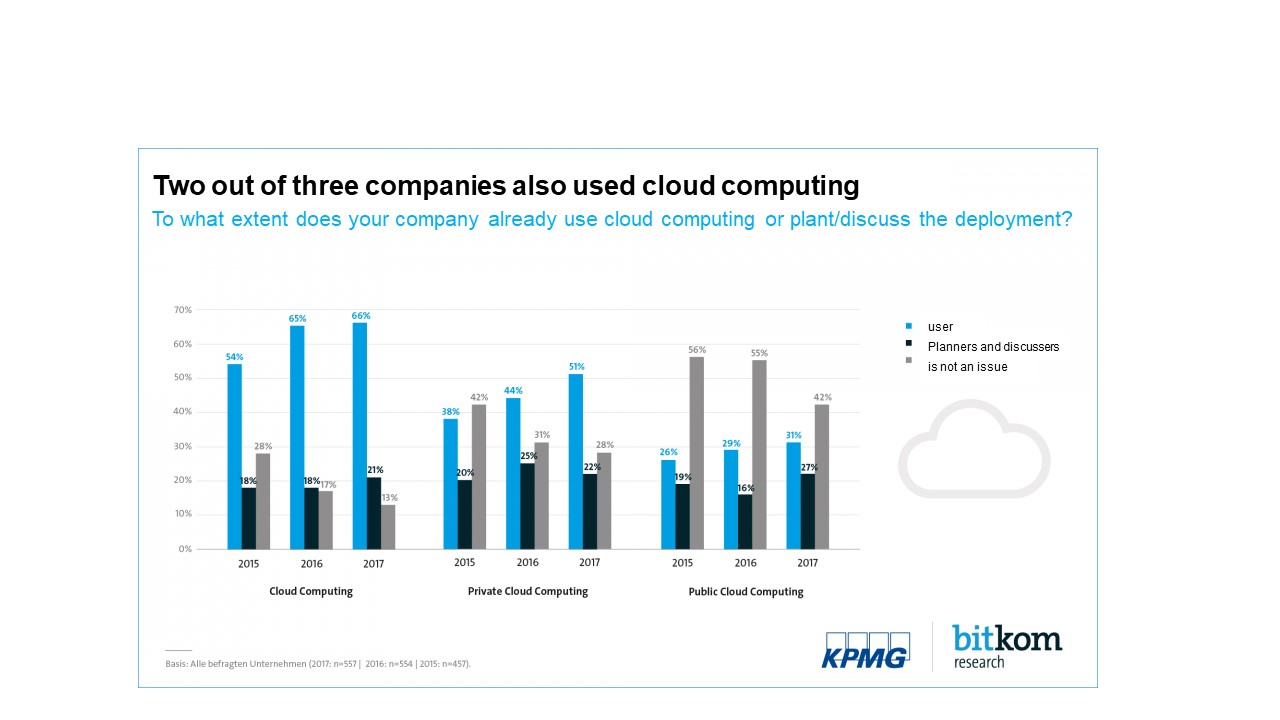
In the beginning there is the process, not the software
28. August 2019
With artificial intelligence on a lifelong learning journey
29. October 2019S
toring company data on an external server still sounds more frightening than promising to many medium-sized companies today. Many companies are now being forced by their IT service providers to offer cloud computing services, and many software providers are also relying only on “SaaS products” (Software as a Service). Generally speaking, cloud computing is a model in which the user can access configurable IT resources such as servers, storage and applications at any time and from anywhere via a network. The advantages of this cloud solution for the specialists are obvious: Large data centers can be operated with relatively minimal effort. Maintenance and servicing is much more efficient than operating local individual servers. In addition, the security standards are extremely high, especially with regard to physical access, and the cloud offers software providers completely new opportunities to retain customers through subscribed license agreements. A recent study by KPMG and bitkom shows that two-thirds of all companies already use cloud computing, but this is mainly the case for large companies (83%). In contrast, SMEs are often very critical of the cloud because the new technology does not appear to be controllable and gives rise to security concerns. Although many SMEs are forced by their software providers to enter the cloud because the software is only offered on a cloud basis, this cloud use is not embedded in a holistic strategy. It would be worthwhile for many companies to use cloud infrastructure, which is significantly cheaper to maintain and also more fail-safe. The only necessary prerequisite is fast Internet access, which companies can use to transfer data in real time. 
What forms of cloud computing are there?
In cloud computing, we differentiate between four basic deployment models: Private cloud: A closed cloud solution that is only available to one company. This is the most common form, as it can even be run on its own servers. Public cloud: Service and applications are provided by a provider to a large group or even the general public. Community Cloud: a group of users with similar interests shares the infrastructure. Hybrid Cloud: Combination of multiple cloud services Regardless of the infrastructure, there are three types of cloud services. (1) “Infrastructure as a Service” in which IT resources are made available, (2) “Platform as a Service” in which the customer uses the cloud infrastructure and (3) in which the service model “Software as a Service” focuses on the provider’s applications. These cloud services differ in terms of their target group. While Software-as-a-Service is primarily aimed at users, the other services are relevant for software development and administrators. This enables them to completely relocate the company’s IT infrastructure to the cloud and take advantage of a flexible structure. Companies must therefore decide how deep the relocation of services to the cloud should be.
Cloud computing delivers scalable IT resources via outsourced infrastructures…
Cloud computing and thus the outsourcing of IT resources offers companies many advantages and is an essential prerequisite for flexible structures. Investment decisions in IT infrastructure can be adapted to the requirements in a freely scalable manner. This offers great advantages, especially for medium-sized companies, as they only pay for what they really need. For example, companies can react flexibly to customer requirements when launching new products. At the same time, the required cloud infrastructure is always well utilized and optimally maintained. In addition to the pure use of resources, many offers include services (e.g. in the security area) at a quality level, which is hardly conceivable as a stand-alone solution for small and medium-sized companies without the cloud. Small and medium-sized companies in particular benefit from services from a service company that are otherwise only available to large companies. This also applies to maintaining redundant structures that significantly increase IT reliability.
… also involves risks with regard to security and costs.
Particularly with regard to data security and data protection, the selection of service providers requires precise control. In the case of globally operating providers, companies should ensure that personal data is stored within the EU in compliance with the EU DSGVO. Switching to the cloud solution also entails a cost and security risk, as it is important to look closely at which data is being moved when, without jeopardizing the stability of the system. By tying to a cloud provider, so-called lock-in effects can also cause a dangerous dependency, which can lead to major outages or additional costs in the event of problems. This shows that the decision for a cloud solution cannot be left to the IT department, but is always a strategic decision.
How can existing systems be transferred to the cloud?
It is easiest for systems whose providers themselves offer the transition to the cloud, but at the user level these are typically software-as-a-service systems. One example is DATEV, which many companies still use as a desktop application on local servers for their accounting. Here DATEV now offers a cloud-based solution with “companies online”, in which the data is stored in a secure cloud and can be accessed using encryption technology. Another example is the extensive range of data storage solutions that are available as public or private clouds and are already frequently used, especially in cross-company collaboration. The advantages here are simple sharing of data and simple assignment of access rights. In this case, the cloud is an enabling tool for distributed work and cooperation.
Where do you start tomorrow?
Three points are crucial when deciding on a cloud solution:
- are there any software / data products that will only be offered in cloud solutions in the future?
- what are the costs of operating my own IT infrastructure in my own company (including all personnel costs for maintenance, etc.)?
- are there any legal or contractual framework conditions that oblige our company to operate its own infrastructure?
Have your IT department create a detailed list to help you answer these questions. Above all, compare the internal costs and failure risks with offers on the market that meet your requirements. In the currently very dynamic cloud market, it is well worth comparing different vendors and negotiating with them. If there is a profitable solution for your IT, or parts of the data and software used, they dare to switch to the cloud. Start with projects that are not existential for your company to gain experience working in the cloud. As an entrepreneur, accompany the necessary cultural change among IT staff as well as all other affected colleagues. The cloud means a change for all employees, but the change must be carried out consistently, otherwise the benefits of a cloud solution will not be available. #Cloud #Cloudcomputing #Server #ITInfrastructure #company #entrepreneurship #future #infrastructure #industry40 #i40 #Make it easy # Sources: https://www.bitkom.org/sites/default/files/2019-06/bitkom_kpmg_pk_charts_cloud_monitor_18_06_2019.pdf




